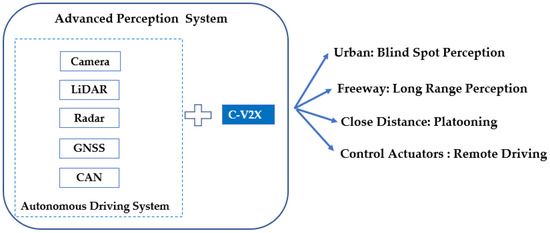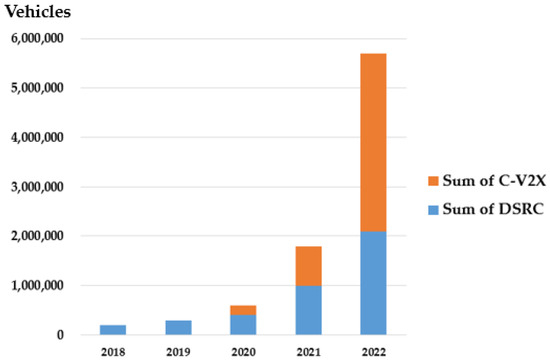1000/1000
Hot
Most Recent

C-V2X (Cellular Vehicle-to-Everything) is a state-of-the-art wireless technology used in autonomous driving and intelligent transportation systems (ITS).
According to the statistics, 1.35 million people die in road accidents worldwide every year, equivalent to 3700 deaths per day[1]. Car crashes have risen to the 8th leading cause of death globally, and C-V2X (Cellular Vehicle-to-Everything) is becoming a popular solution to solve this problem[2]. C-V2X is a communication system that encompasses four sub-categories of applications[3]:
C-V2X uses 3GPP The 3rd Generation Partnership Project) 4G (The fourth-generation) LTE (Long-Term Evolution) or 5G (The fifth generation) NR (New Radio) connectivity to transmit and receive signals. It uses two complementary transmission modes. The first is direct communications to vehicles, infrastructures, and road pedestrians. In this mode, C-V2X works independently of the cellular networks. It uses a PC5 interface for communication. The second mode is cellular network communications, in which C-V2X employs the conventional mobile network to enable vehicles to receive information about road and traffic conditions in the area. It uses Uu interface for communication.
With the evolution and deployment of C-V2X technology, fatal accidents due to human errors or road conditions and massive traffic jams due to special occasions or accidents will no longer be a problem. Detecting risks by C-V2X V2V and V2P before they become a threat and noticing traffic jams by C-V2X V2I and V2N before you see them will be coming soon. This vision of safer roads and more efficient travel can be realized by C-V2X, Intelligent Transport Systems, and 5G together.
C-V2X with low latency and high-reliability allows vehicles to communicate with other vehicles (V2V), pedestrians (V2P), roadside infrastructure (V2I), and networks (V2N) with or without a cellular network[3] and address road safety and traffic efficiency. Typically, autonomous driving vehicles are equipped with advanced sensors: Camera, LiDAR (Light Detection and Ranging), Radar, GNSS (Global Navigation System Satellite), and CAN (Controller Area Network). So why would it still be beneficial for intelligent transportation systems to adopt C-V2X technology? It is because C-V2X can detect potential hazards and road situations from longer distances. A fully equipped autonomous driving vehicle cannot detect non-line-of-sight (NLOS) objects. C-V2X can overcome NLOS problems by using PC5 interface sidelink communication or cellular network for additional safety features. Sensors in the vehicle provide the basic functionalities of autonomous driving; this will not change in the future and is crucial for safety. But the automotive industry, however, has recognized that connectivity is necessary to increase the safety and comfort of L3 (Level 3: Conditional Automation) or L4 (Level 4: Highly Automation) driving further. Going beyond a certain level of driving autonomy will require vehicles to be connected with C-V2X[4].
C-V2X can aggregate information collected in the cooperative perception, update the map with exact road structure information, and distribute the localized HD (High Definition) map to vehicles based on their locations. These enhanced and advanced services such as blind-spot detection, long-range perception, remote driving and platooning, etc. C-V2X can increase road capacity, driver safety, and comfort. All the C-V2X benefits for autonomous driving are summarized in Figure 1.

Figure 1. C-V2X Benefits.
Early V2X technologies, like DSRC (Dedicated Short Range Communication) in the USA and ETSI (European Telecommunications Standards Institute) ITS-G5 in Europe, are based on IEEE (Institute of Electrical and Electronics Engineers) 802.11p, which adds wireless access in vehicular environments (WAVE) at the physical layer and the medium access control (MAC) layer. Currently, 802.11bd is under development as the next-generation standard. DSRC has since been used in many countries for V2V, V2P, and V2I applications. But it has not been commercialized on a large scale for almost two decades[2]. Compared with C-V2X, DSRC has many limitations[5]: (1) Its protocol algorithm CSMA-CD (Carrier Sense Multiple Access with Collision Detection) for V2V and V2I direct communications have hidden nodes, data competition, and collision problems; (2) Its visible and non-visible transmission distances are very limited; (3) It is unable to integrate with the existing cellular mobile network. Hence, in recent years, global V2X development is towards using cellular technology C-V2X, which has high performance and a forward evolutionary path towards 5G, to support terminal mobility such as seamless handover and roaming abilities. USA federal government agency NHTSA (National Highway Traffic Safety Administration) expressed its favor for C-V2X[6]. Furthermore, FCC (Federal Communications Commission) has recently announced its preference of C-V2X over DSRC for ITS (Intelligent Transport Systems) radio service[2].
Worldwide forecast for the number of vehicles equipped with V2X technology is shown[7] in Figure 2.

Figure 2. Worldwide forecast for the number of vehicles equipped with V2X technology[7].
It is worth mentioning that DSRC and C-V2X technologies are addressing similar use-cases. They have an identical network, security, and application layers; the only difference is in the access layer. Therefore, some companies[8][9] are delivering dual-mode functionality device to support both DSRC and C-V2X technologies. Technology is meaningful only when it can serve humans. It is yet to be seen which one will the market prefer.
Even 802.11p based V2X technology was early adopted by some global automotive manufacturers as an electronic toll collection technology because C-V2X demonstrates a forward evolutionary path towards 5G. 5GAA[10] started to develop C-V2X technology. Moreover, FCC (Federal Communications Commission) officially announced to allocate 5.9 GHz ITS spectrum for C-V2X in December 2019[21]. Finally, FCC decided to retain 30 megahertz of spectrum in the 5.895–5.925 GHz for the ITS radio services using C-V2X technology in November 2020[2]. Meanwhile, Europe is developing a new EN (European Standard) to define the use of C-V2X as an access layer technology for C-ITS (Cooperative-Intelligent Transport System), which is approved by ETSI. Australia originally started on-road tests of C-V2X technology in Victoria, late 2018. In China[10][14], first C-V2X trials were launched in 2016 by using Triple-level CATT(Datang), Huawei Hisilicon and Qualcomm chipset. Interoperability testing of PC5-based LTE-V2X applications with Multi-vendor Interoperability had finished in Shanghai in November 2018, and C-V2X “Four Layers” Interoperability Application Demonstration focusing on security mechanism was organized in Shanghai in October 2019. Japan C-V2X trial began in 2018, and the use cases include V2V, V2P, V2I, as well as V2N operations over cellular network-based wide area communications with cloud access. South Korea had successfully demonstrated 5G C-V2X communications between autonomous test vehicles (AVs) in 2019.
Considering the current 3GPP releases and supply chain readiness, 5GAA even developed a long-term blueprint of traffic efficiency and basic safety C-V2X use cases worldwide in September of 2020[22] as shown in Figure 5.

Figure 5. Timeline from the initial introduction to the mass market deployment of C-V2X Use cases[22].
As a result, C-V2X has gained momentum in the United States, Europe, Australia, China, Japan, Korea, and other markets. C-V2X is dominating globally, and Taiwan is one of the countries at the forefront of C-V2X development supported by the government in the intelligent transportation systems programs[23].